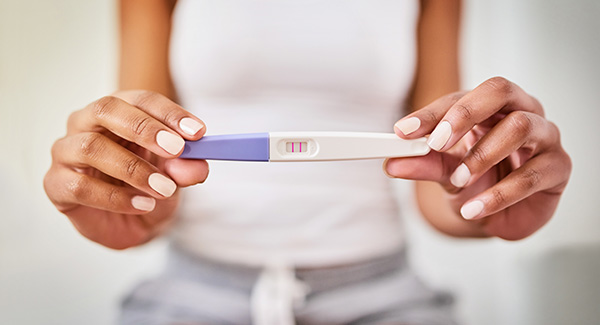Fertility Treatments Are Safe for Many With Arthritis
Inflammatory arthritis and its treatments can make conception harder; fertility treatments may make it easier.
By Linda Rath | Oct. 4, 2022
Having a rheumatic disease can make conception more challenging and complicated. Most couples get pregnant after six months to a year of trying to conceive. But pregnancy may take longer or be impossible for some people with inflammatory forms of arthritis, like rheumatoid arthritis, and lupus.
There are several reasons for this. Some are directly tied to arthritis medications, including nonsteroidal anti-inflammatory drugs (NSAIDs), which are associated with a longer time to conception, and cyclophosphamide (Cytoxan) — used to treat lupus nephritis and interstitial lung disease among other conditions — which can cause infertility in both men and women. Some research links infertility to high disease activity and inflammation. Hormone-disrupting chemicals called phthalates, found in products from plastics to drug coatings and cosmetics, are also associated with infertility and other reproductive problems in women with rheumatic disease as well as those without disease.
What About Fertility Treatments?
Fertility treatments such as in vitro fertilization (IVF) and cryopreservation (freezing eggs, sperm or fertilized embryos) may be options if you wish to have a biological child but haven’t been able to conceive naturally. These procedures — known medically as assisted reproductive technologies (ART) — are generally safe for many, but not all, people with arthritis.
As with a natural pregnancy, your arthritis symptoms must be well controlled for at least six months before IVF, and any medications you take must be safe for you and a potential fetus. Ideally, you should also test negative for antiphospholipid (aPL) antibodies. About 50% of lupus patients have aPLs. They’re also found in up to one-third of those with scleroderma as well as in people who don’t have arthritis.
If you’re aPL-positive but don’t have symptoms or have been treated for antiphospholipid syndrome, it’s still possible to have fertility treatments. You may be taking warfarin to prevent blood clots; if so, you’ll need to switch to an anti-clotting drug like heparin or low-molecular-weight heparin, which is safer to use during pregnancy, before the procedures. If you have lupus, RA, scleroderma or Sjogren’s syndrome, you should also be tested for autoimmune antibodies called anti-Ro/SSA and anti-La/SSB before undergoing fertility treatments. These antibodies are associated with poor outcomes for both the pregnant person and fetus.
What ART Involves
In vitro fertilization (IVF) is the most effective form of assisted reproduction. It’s also time-consuming, invasive and involves a series of complicated steps and potential complications, including:
- Hormone shots. Your body normally releases one egg each month (two in the case of non-fraternal twins). To start IVF, you need daily hormone shots to encourage your ovaries to produce more eggs. These high levels of hormones can lead to complications, including flares, blood clots and ovarian hyperstimulation syndrome (OHSS), which can cause the ovaries to swell and leak fluid. Be sure to discuss OHSS-prevention strategies with your doctor. One alternative is to avoid medications by using the egg(s) you produce during normal ovulation — a process called natural cycle IVF — however, the implantation rates of this method are generally low.
- Egg retrieval. Once you have enough mature eggs — usually a minimum of six or seven per cycle — they’re collected using ultrasound aspiration. This is a procedure in which a fine needle connected to a suction device is used to remove the eggs.
- Fertilization. Your eggs are fertilized by sperm in a lab. During conventional IVF, the egg is placed in a dish with lots of sperm, which penetrate the egg naturally. In a technique called intracytoplasmic sperm injection, a single sperm is directly injected into each egg. This technique hasn’t been shown to improve outcomes except in cases of male infertility. It’s also linked to potential genetic abnormalities and birth defects and raises the cost of treatment considerably.
- Pre-implantation genetic testing. You may choose to have your fertilized embryos tested for genetic abnormalities to improve your chance of a healthy pregnancy and infant. Yet how to interpret certain test results and how to advise prospective parents isn’t always clear. For example, “mosaic embryos,” which have both normal and abnormal genes, are less likely to implant or lead to a healthy pregnancy, but some mosaic embryos have better outcomes than others. It’s also not clear whether ART increases the risk of birth defects, although studies haven’t found any increased risk from pre-implantation genetic testing itself.
- Implantation. No more than two fertilized embryos are implanted in the uterus. One may not survive, but this also can result in a twin pregnancy.
What Are the Chances?
When it comes to fertility treatments, success is defined by the number of live births, not the number of pregnancies. Giving birth to a healthy baby depends on many factors, but your age is the most important. Once you reach your 40s, it becomes harder to achieve a successful outcome. After age 43, your chance of success is just 10%.
Your reproductive history, reason for infertility, various lifestyle factors, type of embryo transfer and the fertility clinic you use all play a role. Studies have not found that arthritis affects IVF outcomes as long as your disease is well controlled and you’re closely monitored by your rheumatologist, reproductive specialist and, if you become pregnant, an obstetrician or gynecologist.
You can find an IVF Fertility Estimator on the Centers for Disease Control and Prevention website. It allows you to estimate your chances of a live birth based on data from U.S. fertility clinics and people with characteristics similar to yours.
Fresh Versus Frozen
One alternative to undergoing IVF with fresh embryos is to freeze them for future use. Freezing eggs or embryos when you’re younger may make it easier to get pregnant when you feel more ready. It may also prevent you from having to go through hormone stimulation during repeat cycles.
So far, there’s no evidence that frozen embryos are more prone to birth defects, and recent studies have shown that the number of live births using fresh or frozen eggs is about the same. Risks are also similar, including:
- A slightly greater chance of a premature or low-birth weight infant — a risk already increased in people with arthritis.
- Miscarriage. The rate of miscarriage for people undergoing IVF is about the same as in the general population. It is slightly higher for people with arthritis and increases with age.
- Repeat IVF cycles. Many people don’t get pregnant during their first IVF treatment (called a cycle), and they may undertake several attempts before becoming pregnant or deciding to stop treatment.
- Emotional distress. IVF is stressful in many respects, including intense disappointment if you don’t become pregnant after undergoing multiple IVF cycles. Although most fertility specialists recommend and provide counseling, it’s also important to have your own support system in place before starting the treatments. IVF’s emotional ups and downs — as well as the hormones you take — can lead to depression, so it’s important to have support throughout the process.
- Financial stress. No matter where you live or what procedures you have, IVF is expensive. A fertility clinic may quote you a base price of $12,000 to $15,000, but you may end up paying around $24,000 for a single IVF cycle, according to the Kaiser Family Foundation. The cost of a successful outcome, defined as a live birth, is about $61,000. If you use a donor egg, the price jumps to $73,000. These costs don’t include office visits, diagnostic and genetic testing or donor sperm or eggs. You’ll pay $3,000 to $6,000 just for medications. Figure on another couple of thousand dollars to flash-freeze eggs or embryos. Medicaid and most private insurers won’t cover fertility treatments, so it’s essential to understand and get written estimates of all your costs upfront.
For people who deliver a healthy infant using fertility services, the experience is ultimately well worth it. It’s important to keep in mind, though, that not every story is a success. The cost of these procedures puts them out of reach for many, while certain health considerations make them inaccessible for some people with arthritis.

Stay in the Know. Live in the Yes.
Get involved with the arthritis community. Tell us a little about yourself and, based on your interests, you’ll receive emails packed with the latest information and resources to live your best life and connect with others.



